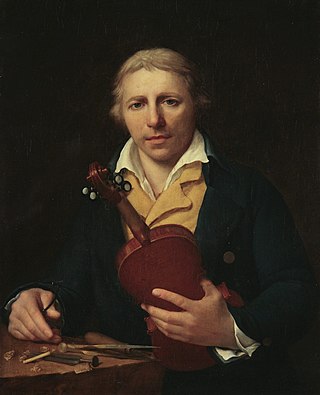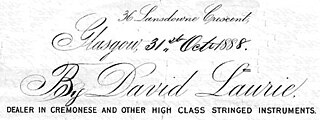Related Research Articles
The Guarneri, often referred to in the Latinized form Guarnerius, is the family name of a group of distinguished luthiers from Cremona in Italy in the 17th and 18th centuries, whose standing is considered comparable to those of the Amati and Stradivari families.

Charles Jean Baptiste Collin-Mezin (1841–1923) was a French maker of violins, violas, cellos, basses and bows. He was an Officier de l'Académie des Beaux-Arts and won gold and silver medals at the Paris Exhibitions in 1878, 1889, and 1900.
Luigi Tarisio was an Italian violin dealer and collector.

Giovanni Grancino (1637–1709), son of Andrea Grancino, was one of the early Milanese luthiers, and may have worked with his brother, Francesco.

Carlo Annibale Tononi (1675–1730) was a luthier who trained and worked with his father in the Tononi family workshop in Bologna, Italy, until his father, Johannes Tononi, died in 1713. After his father's death, Tononi moved to the more important center of music in Italy, Venice.

Gaetano Pollastri (1886–1960) was a professional violinist but after the first world war he devoted himself to violin making. He worked with the same company as his brother in via Castiglione, that was devoted to the construction, repair and commerce of string instruments. In 1927 he received the Certificate of Honour at the contemporary violin making exhibition-competition in Cremona. When Augusto died in 1927, he took over his brother's company. In the following twenty years Gaetano constructed numerous instruments of which, in 1930, a violin with papal coat of arms that he personally donated to Pope Pious XI. He also restored precious violins; among them, a Stradivari and a Guarneri of Guglielmo Marconi brother's property, Alfonso. He won the Certificate of Honour in Cremona in 1949. In 1954 he showed two violins at the 2nd National Competition of Contemporary violin making in Rome, obtaining a Certificate of Honour, and was present with his instruments at the Ascoli Piceno ('54) and Pegli ('56) competitions. He worked very hard to promote his profession and was a founding associate of the ANLAI. His students include Cesare Pollastri, Franco Albanelli and Otello Bignami.
Franz Albert Nürnberger II (1854–1931) is regarded as one of the greatest German bow makers.
Nikolai Ferdinandovich Kittel was a Russian Empire violin and bow maker who is often still mistakenly considered as of German origin, and was known as the "Russian Tourte". According to the latest findings, his full name was Nikolai Ferdinandovich Kittel and that he was of Austrian origin as stated in his marriage certificate. Kittel always signed letters and invoices with the name Nikolai Kittel. In all German and French documents, he was named Nikolai, and not Nikolaus.

Giovanni Francesco Pressenda was an Italian violin maker.

Ansaldo Poggi was born in Villafontana di Medicina (Bologna), 9 June 1893 and died in Bologna, 4 September 1984. He demonstrated his talent for the making of stringed instruments at a young age. His father, also an artisan, musician and amateur violinmaker, encouraged his son, steering him toward the arts. After the end of World War I he dedicated himself to the profession, taking up the craft again alongside his father while at the same time graduating from the Philharmonic Academy of Bologna. In 1921 he met up with the famous luthier Giuseppe Fiorini, of whom he was an adored disciple. In 1923 he won his first silver medal with a viola at the National Competition in Rome.

Augusto Pollastri was an Italian violin maker, older brother to Gaetano Pollastri. Started his career as an apprentice in Raffaele Fiorini's studio. Augusto's father was a miller and an amateur musician. Augusto was exposed to music early on, he also enjoyed visiting the shop of a famous violin maker Raffaele Fiorini, where he started to perform small services in the shop, which led to an apprenticeship with maestro Fiorini.

Nicolas Lupot was one of the most illustrious French luthiers of his time.

David Laurie - was a distinguished 19th century violin collector.
Ludwig Christian August Bausch was a German Bogenmacher / bow maker. He became known as the "German Tourte".
Heinrich Carl Knopf (1839–1875) was a German bowmaker or bogenmacher.
William Lewis & Son was a distinguished Chicago-based music store that specialized in violins and bows. The firm was founded in 1874. In 1995, the company was purchased by Selmer, and has since become a division of Conn-Selmer, Inc., a wholly owned subsidiary of Steinway Musical Instruments.
Hermann Wilhelm Prell (1875–1925) was a skillful German bow maker. He was born on July 29, 1875, in Bad Brambach, Germany.
Die Geigen- und Lautenmacher vom Mittelalter bis zur Gegenwart is one of the earliest comprehensive reference books for violins and luthiers. It was compiled by Willibald Leo von Lütgendorff (1856–1937) and originally published in 1904.
Charles François Gand (1787–1845) was one of the foremost violin makers/luthier and dealers of his time.

Charles Mennégand was a French luthier and a repairer of violins, violas, and cellos. He is considered a superb 19th century French maker of cellos and is consistently counted among the handful of great French makers.
References
- ↑ Who's Who in Music and Musicians' International Directory, Sixth edition, New York: Hafner Publishing Co. (1972) ISSN 0083-9647 OCLC 1805141
- 1 2 Freaks of Disordered Thought, by Alan Coggins, The Strad (October 2003) ISSN 0039-2049
- ↑ Journal of the American Musical Instrument Society , 2002, Vol. 28, pg. 7 OCLC 60638292
- ↑ Die Geigen und Lautenmacher vom Mittelalter bis zur Gegenwart (The Violin and Lute Makers From the Middle Ages to the Present), by Willibald Leo von Lütgendorff (1922) OCLC 2110375
- ↑ Ältere und neuere Literatur zur Musikinstrumentenkunde, by John Henry van der Meer, Acta Musicologica, Vol. 51, Fasc. 1 (Jan. – Jun., 1979), pgs. 34–35, published by the de:International Musicological Society (accessed: 18/10/2013), OCLC 4892830290, ISSN 0001-6241